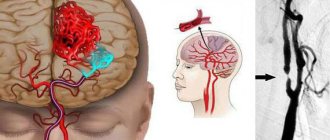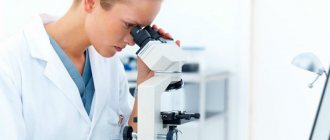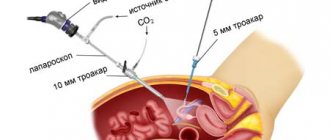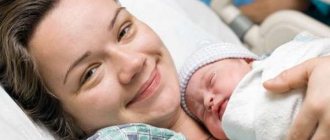Ultrasound examination is now the most common diagnostic method for various gynecological problems in women. In the protocol, the doctor gives a description of the various organs and structures of the small pelvis and records their sizes. These are the body of the uterus, the cervix, the ovaries, which are understandable to almost everyone, and the M-echo, which is known to few patients. What is it, what is normal and what does it mean, we will look at it in this article.
What is an ultrasound echo in gynecology?
The endometrium is the functional mucous membrane of the uterine cavity, structurally dependent on the menstrual cycle and its current phase, consisting of a base and functional layer. This structure of blood vessels and glandular cells is formed under the influence of female sex hormones.
IMPORTANT: The main function of the endometrium is to create conditions in the uterus favorable for implantation and fixation of a fertilized egg. Afterwards, it participates in the formation of the placenta.
Endometrium.
M-echo determines the thickness of the endometrial layer of the uterus, and it changes in accordance with the days of the female cycle and is associated with changes in hormonal levels.
- The beginning of the cycle is called the proliferative or follicular phase, when the mucous layer grows
- In the middle of the cycle, the endometrium acquires the consistency of a sponge and becomes thicker under the influence of progesterone.
- If fertilization does not occur, the synthesis of estrogen and progesterone is inhibited, the functional layer of the endometrium is rejected
Types of pathology
Hyperplastic processes in the endometrium can have 4 different forms of flow, namely:
- Ferrous.
- Glandular-cystic.
- Focal.
- Atypical.
One of the most common forms of the hyperplastic process is glandular pathology. It is accompanied by the proliferation of glandular tissues, but has a less dangerous course, as it develops over a very long period of time. But we should not forget that the development of glandular hyperplasia in the absence of appropriate treatment can develop into oncology.
A less common variant of hyperplastic processes are glandular-cystic pathologies. This is a rather dangerous form of hyperplasia, characterized by the formation of cystic lesions of the mucous membranes of the uterine cavity. In 5-6% of cases they can also develop into a cancerous tumor of the endometrial layer.
Focal forms of hyperplastic processes are quite rare, but are one of the most dangerous pathological disorders of the endometrium. When this form develops, no therapeutic treatment is used. In this case, strict control is maintained over the development of polyps that have a high predisposition to malignancy.
This form of the disease requires immediate surgical treatment.
The development of the hyperplastic process over a long period of time is accompanied by rather mild symptoms. As the thickness of the endometrial layer increases, a woman may experience bleeding, which cannot be ignored.
Other symptoms of the development of hyperplasia in the endometrial layer make themselves felt in quite rare cases. Sometimes, as this pathology progresses, white or gray spotting discharge may be observed. Pain during hyperplastic processes does not appear.
The development of this pathology, in most cases, is detected during a routine examination in the gynecological office.
M - echo of the uterus: norm by day of the cycle
- At the beginning of menstruation, the uterine cavity can expand up to 5 mm. Heterogeneous hypoechoic or hyperechoic inclusions are recorded (these are blood clots). This phase typically lasts 3 or 4 days
- During the proliferative phase, over the next 12 to 14 days, the size of the endometrium gradually increases. The increase is fixed at 0.1 mm daily. Ultrasound reveals reduced echogenicity of the endometrium and its uniform structure. A bright hyperechoic stripe and a hypoechoic muscular layer of the uterus are also determined, therefore the M-echo image is called three-layer
- Then ovulation occurs, lasting from several minutes to several hours; it is elusive on ultrasound
- During the periovulatory phase, an increase in the echogenicity of the endometrium is observed, its echostructure is homogeneous. M-echo is 10-12 mm. It is five-layered due to the hyperechoic contour visualized at the border of the mucous and muscular layers of the uterus
- During the luteal phase, the contour between the anterior and posterior walls of the endometrium often disappears. The echogenicity of the mucous layer increases compared to the echogenicity of the muscular layer. M-echo increases, averaging 10 mm, maximum 15 mm
The m-echo indicator on ultrasound of the uterus varies depending on the phase of the menstrual cycle.
Diagnostic measures
In cases where a woman, taking care of her health, undergoes regular scheduled examinations, there will be no problems with the timely detection of pathological changes in the uterine cavity. Since during the examination, special gynecological mirrors are used, which allow one to clearly see the fibrous and glandular-cystic types of hyperplasia.
As mentioned above, the endometrium has a certain thickness norm, the excess of which indicates pathology. The thickness of the endometrium is detected using an ultrasound diagnostic method.
Based on the results obtained and after all diagnostic procedures, the specialist develops the most effective scheme for further treatment.
Thickness of m-echo by day of the cycle
The table shows normal and acceptable midline echo values in women with a standard 28-day cycle.
Median echo by day of the cycle.
IMPORTANT: If the cycle is longer, for example, 30 or 31 days, then a slight lag in the growth of endometrial thickness is considered normal. If it’s shorter, then, on the contrary, the m-echo grows faster
How to prepare for the procedure
When preparing for M-Echo, it is necessary to take into account the examination technique. When conducting a transabdominal examination, it is necessary to adhere to a dietary regimen. The day before the procedure, foods that contribute to increased gas formation (cabbage, legumes, bakery or confectionery products) are excluded from the diet.
For accurate imaging, it is recommended to drink at least 1 liter of fluid and not urinate 1 hour before the test.
For transvaginal examination, on the contrary, it is recommended to empty the bladder immediately before the procedure. Dietary recommendations are similar to those for transabdominal M-Echo.
M - echo of the uterus during early pregnancy
If pregnancy occurs, the endometrium grows to a width of 20 mm or more.
IMPORTANT: Even if the fertilized egg is not yet detected by ultrasound in the uterine cavity, based on how the endometrium has grown, a gynecologist can determine pregnancy.
Unfortunately, this indicator can be present both during pregnancy, both uterine and ectopic, because the growth of the endometrium occurs due to a sharp change in hormonal levels. The number of secretory cells and blood vessels also increases significantly, since during this early period of pregnancy their function is similar to the function of the placenta - to provide nutrition to the embryo.
Development of endometrial hyperplasia
Many women who have entered the threshold of menopausal changes stop paying attention to their health. They attach special importance to all ailments that appear during this period of time, attributing everything to changes in hormonal levels. But, of course, you can’t treat yourself like that. After all, it is with the onset of menopause in the female body that the level of the immune defense system weakens.
And she is at greatest risk of developing serious pathologies: from benign neoplasms to cancer. Therefore, regular examination in a gynecological office is so necessary: at least 2 times a year, during which the initial stages of development of disorders can be detected.
This pathology of the endometrium in menopause develops under the influence of hormonal changes in the body. The following factors also contribute to the development of pathology:
- being overweight;
- pathological change in liver functionality;
- development of diabetes mellitus;
- progressive stage of hypertension;
- hereditary factor.
This pathology of the endometrium in postmenopause is quite dangerous, as it can progress to the stage of malignancy and degeneration into a cancerous tumor. The development of atypical hyperplasia can result in cancer in 25% of cases. To prevent such complications, it is necessary to know the norms of the state of the body’s reproductive system during the fertile and menopausal periods.
M echo after childbirth
After childbirth, the uterus continues to contract. A couple of days after birth, its size corresponds to the size of the uterus of an 18-week pregnancy, after 7 days it corresponds to a 12-week pregnancy, and by the sixth week it returns to its normal parameters.
Endometrial echo: normal
They are shown in the table:
Table 1.
Table 2.
Indications for the study
M-Echo of the uterus is performed on women of all ages. This is necessary not only for preparation for pregnancy, but also for dynamic monitoring in postmenopause.
Main indications:
- pregnancy planning;
- dysmenorrhea;
- chronic diseases of the reproductive system;
- soreness over the womb;
- intermenstrual bleeding;
- infertility;
- pre- and postmenopause.
The study is also carried out as part of preventive examinations. This contributes to the early detection and treatment of pathologies.
M-echo of the uterus: normal during menopause
The indicators of the median echo of a woman during menopause differ from those established for women of childbearing age. This is due to hormonal imbalance. Ultrasound determines:
- highly echogenic endometrium
- its homogeneous structure
- smooth contours
During menopause up to 5 years, the mucous layer gradually thins to 5 mm, then decreases until it is not visualized at all.
IMPORTANT: A woman with menopause is recommended to undergo an ultrasound approximately once every six months in order to prevent hyperplastic processes.
Endometrial norms during menopause
All processes of changes in the endometrium during menopause and the postmenopausal period must be carefully monitored to prevent serious complications and the development of oncology.
Ultrasound diagnostic methods are the most effective and reliable ways to determine the condition of the uterine organ and the norm in the endometrium during menopause.
If the thickness of the endometrium in menopause exceeds 8 mm, then this indicates the development of a pathological process. In this situation, in order to make an accurate diagnosis, a specialist performs a diagnostic curettage of the uterine cavity.
In the case when the endometrium in menopause, that is, its thickness itself, greatly exceeds 12-13 mm, separate curettage of the mucous membrane is carried out and the biological material obtained from the uterine cavity is sent for histological examination.
It is important to remember that curettage methods are necessary in case of violations of the norms of endometrial thickness in order to study the structure of the resulting material, make an accurate diagnosis and begin appropriate treatment.
Treatment methods
In modern medicine, there are a large number of varieties of therapeutic treatment methods: both conservative and surgical.
In the case where the cause of the development of pathology is a change in the hormonal background in the female body, and the thickness of the endometrial layer undergoes minor changes in indicators, hormone replacement therapy will be effective. In most cases, medications containing the hormone progesterone are prescribed. The duration of hormonal treatment can take from 3 months to a year.
Another type of treatment for hyperplastic processes in the endometrium is surgical methods. Initially, a diagnostic curettage procedure is performed, on the basis of which a specific diagnosis is established. Moreover, the developing pathological process is also slowing down and the developing uterine hemorrhage is stopping.
If localized processes of hyperplastic growths are detected, then ablation, or cauterization of the thickened layers of the endometrium, is performed. In case of an atypical form of development of hyperplasia, surgical hysterectomy is prescribed, that is, complete removal of the uterine organ. But such a radical treatment method is used when there is no effect from hormone replacement therapy, as well as while maintaining the likelihood of transition to malignancy and the development of a cancerous tumor.
In modern medicine, combined methods for the treatment of hyperplastic processes in the menopausal period are increasingly being used. Consisting in the initial use of hormone replacement drugs that help reduce lesions. Then the remaining small defects are excised surgically.
In addition to hormones during the menopausal period, vitamin complexes are also prescribed to help strengthen the immune defense system of the female body and contribute to a noticeable improvement in overall well-being.
But they can still be used as an addition to the main treatment. It is recommended to use decoctions or infusions of medicinal plants only after general agreement with a qualified specialist.
To prevent the development of such pathological changes in the reproductive system of the female body, it is necessary to give up bad habits, promptly eliminate the inflammatory process, using appropriate treatment, and lead a healthy lifestyle. And getting rid of excess weight will not only transform your appearance, but will also be a good preventive measure against many pathologies.











